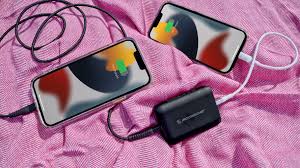Power stations provide essential electricity for camping trips, home emergencies, and even daily off-grid use. One common question users have is whether they can safely operate their devices while the power station itself is charging. This feature, known as pass-through charging, offers great convenience but requires understanding its limitations. Some models support it seamlessly, while others may risk overheating or reduced battery life if mishandled. Knowing how to balance immediate power needs with long-term device health is key. In this article, we’ll explore how pass-through charging works, safety precautions, performance trade-offs, and best practices for uninterrupted power.
1. Understanding Pass-Through Charging
Pass-through charging allows a power station to charge its internal battery while simultaneously supplying power to connected devices. This is especially useful during extended outages or when solar panels are replenishing the battery slowly. Not all power stations support this feature—some will prioritize either charging or discharging to protect the battery. Units with advanced circuitry can manage both processes efficiently, but performance varies based on power draw and charging speed. For example, running a laptop while charging the station may work fine, but high-wattage appliances like microwaves could slow down charging significantly. Always check your model’s specifications to confirm pass-through capability.
2. Safety Considerations
Heat Management During Dual Operation
Using a power station while charging generates additional heat, which can strain components if not properly managed. Most modern designs include cooling fans and temperature sensors to prevent overheating, but prolonged high-load use may still cause excessive warmth. Placing the unit in a well-ventilated area, away from direct sunlight or enclosed spaces, helps dissipate heat. If the exterior feels unusually hot to the touch or the fan runs continuously at high speed, reduce the power load or pause charging temporarily. Overheating can accelerate battery degradation, so monitoring thermal performance is crucial for safety.
Manufacturer Guidelines to Follow
Manufacturers often specify limits for simultaneous charging and discharging. Some advise against using pass-through mode for high-wattage devices, while others cap the total output during charging. Ignoring these guidelines may void warranties or cause premature battery failure. For instance, continuously draining the battery faster than it charges can lead to deep discharges, which harm lithium-ion cells over time. Always review the user manual for model-specific recommendations—what works for one power station might not be safe for another. When in doubt, err on the side of caution to extend your unit’s lifespan.
3. Performance Impact
Charging Speed vs. Power Output
When using pass-through charging, the power station divides available energy between recharging the battery and powering connected devices. If you’re running energy-intensive appliances, the battery may charge much slower or even discharge slightly over time. For example, charging at 100W while powering a 200W fridge means the battery loses net energy. This isn’t necessarily harmful for short periods but can be problematic during long-term use. Planning energy priorities—like charging the station first, then running devices—can optimize efficiency. Solar charging users should note that cloudy conditions exacerbate this balance challenge.
Battery Stress and Long-Term Effects
Frequent pass-through use can contribute to gradual battery wear, especially if the unit operates at high temperatures or near full capacity. Lithium-ion batteries degrade faster when consistently cycled under heavy loads, reducing their overall lifespan. To minimize stress, avoid stacking high-power demands (e.g., air conditioners + charging) and unplug devices once the battery reaches a stable level. Some power stations include battery management systems (BMS) to mitigate these effects, but mindful usage remains the best practice. Think of pass-through as a convenience feature rather than a daily operating mode.
4. Best Practices for Simultaneous Use
Recommended Power Load Limits
A good rule of thumb is to keep the combined load below 70–80% of the power station’s maximum output during charging. This prevents excessive strain on the inverter and battery. For example, if your station can output 500W, try to limit device usage to 350–400W while charging. Prioritize essential devices (like medical equipment or routers) over discretionary ones (like blenders or gaming consoles). Some models display real-time power allocation, helping you stay within safe limits. Periodically check the battery level to ensure it’s not depleting unintentionally.
Optimal Environmental Conditions
Heat is the enemy of both performance and safety, so operate your power station in a cool, dry place. Avoid humid or dusty environments, as moisture and debris can interfere with cooling systems. If using solar panels, position the station in the shade while allowing panels to stay in sunlight. For indoor use, ensure the room has adequate airflow—placing the unit near a vent or fan can help. In extreme temperatures (below freezing or above 95°F/35°C), consider pausing pass-through use altogether to protect the battery.
5. Alternatives When Pass-Through Isn’t Available
If your power station doesn’t support pass-through charging or you’re concerned about battery health, alternatives exist. Charge the unit fully first, then disconnect the charger before powering devices. For solar users, a separate battery bank can store energy while the main station runs appliances. In emergencies, rotating device usage—charging phones in batches, for example—conserves power without overloading the system. Some advanced setups even allow linking multiple power stations for expanded capacity.
Conclusion
Pass-through charging is a valuable feature for uninterrupted power, but it requires careful management to avoid overheating or battery damage. By understanding your power station’s limits, monitoring heat levels, and prioritizing energy needs, you can use this function safely. For hassle-free operation, EcoFlow products undoubtedly stand out—their advanced technology allows continuous charging while in use, ensuring seamless power without compromising safety or convenience. Whether for emergencies or outdoor adventures, informed usage ensures your power station remains reliable for years to come.








